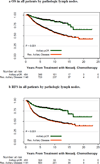Ten-Year Outcomes of Patients With Breast Cancer With Cytologically Confirmed Axillary Lymph Node Metastases and Pathologic Complete Response After Primary Systemic Chemotherapy
- PMID: 26720612
- PMCID: PMC4845895
- DOI: 10.1001/jamaoncol.2015.4935
Ten-Year Outcomes of Patients With Breast Cancer With Cytologically Confirmed Axillary Lymph Node Metastases and Pathologic Complete Response After Primary Systemic Chemotherapy
Abstract
Importance: The long-term effect of axillary pathologic complete response (pCR) on survival among women with breast cancer treated with primary systemic chemotherapy (PST) is unknown.
Objective: To assess the long-term effect of axillary pCR on relapse-free survival (RFS) and overall survival (OS) in women with breast cancer with cytologically confirmed axillary lymph node metastases treated with PST.
Design, setting, and participants: We retrospectively analyzed the effect of axillary pCR on 10-year OS and RFS among all women who received a diagnosis of breast cancer stages II to III with cytologically confirmed axillary metastases between 1989 and 2007 who received PST at a large US comprehensive cancer center. Women were stratified by post-PST axillary status, and survival outcomes were estimated and compared according to response in the breast and axilla.
Main outcomes and measures: Outcomes of interest were RFS and OS.
Results: Of 1600 women treated, median (range) age at diagnisis was 49 (21-86) years. A total of 454 (28.4%) achieved axillary pCR. These patients were more likely to have human epidermal growth factor receptor 2 (HER2)-positive and triple-negative disease (P < .001), pCR in the breast (P < .001), high-grade tumors (P < .001), and lower clinical and pathologic T stage (P = .002). Ten-year OS rates were 84% (95% CI, 79%-88%) and 57% (95% CI, 54%-61%) (P < .001) and 10-year RFS rates 79% (95% CI, 74%-83%) and 50% (95% CI, 46%-53%) (P < .001) for patients with axillary pCR and residual axillary disease, respectively. For patients with axillary pCR, 10-year OS rates were 90% (95% CI, 84%-94%) for those with breast pCR and 72% (95% CI, 61%-80%) for those with residual breast disease (P < .001). For patients with residual axillary disease, 10-year OS rates were 66% (95% CI, 56%-74%) for patients with and 56% (95% CI, 52%-60%) for patients without breast pCR (P = .02). Of patients receiving HER2-targeted therapy for HER2-positive disease, 67.1% (100 of 149) achieved axillary pCR; 10-year OS rates were 92% (95% CI, 84%-96%) and 57% (95% CI, 20%-82%) (P = .003) and 10-year RFS rates 89% (95% CI, 81%-94%) and 44% (95% CI, 18%-68%) (P < .001) for those with axillary pCR and residual axillary disease, respectively.
Conclusions and relevance: Axillary pCR was associated with improved 10-year OS and RFS. Patients with axillary and breast pCR after PST had superior long-term survival outcomes. Patients undergoing HER2-targeted therapy for HER2-positive disease had high rates of axillary pCR, and those with axillary pCR had excellent 10-year OS.
Conflict of interest statement
None of the authors has any conflicts of interest to report.
Figures




Comment in
-
Parsing Pathologic Complete Response in Patients Receiving Neoadjuvant Chemotherapy for Breast Cancer.JAMA Oncol. 2016 Apr;2(4):516-7. doi: 10.1001/jamaoncol.2015.4919. JAMA Oncol. 2016. PMID: 26720160 No abstract available.
References
-
- Mauri D, Pavlidis N, Ioannidis JP. Neoadjuvant versus adjuvant systemic treatment in breast cancer: a meta-analysis. J Natl Cancer Inst. 2005;97(3):188–194. - PubMed
-
- Fisher B, Bryant J, Wolmark N, et al. Effect of preoperative chemotherapy on the outcome of women with operable breast cancer. J Clin Oncol. 1998;16(8):2672–2685. - PubMed
-
- Kuerer HM, Newman LA, Smith TL, et al. Clinical course of breast cancer patients with complete pathologic primary tumor and axillary lymph node response to doxorubicin-based neoadjuvant chemotherapy. J Clin Oncol. 1999;17(2):460–469. - PubMed
-
- Hennessy BT, Hortobagyi GN, Rouzier R, et al. Outcome after pathologic complete eradication of cytologically proven breast cancer axillary node metastases following primary chemotherapy. J Clin Oncol. 2005;23(36):9304–9311. - PubMed
Publication types
MeSH terms
Substances
Grants and funding
LinkOut - more resources
Full Text Sources
Other Literature Sources
Medical
Research Materials
Miscellaneous

